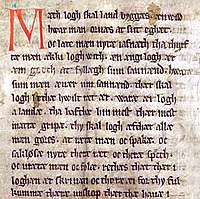
Photo from wikipedia
This paper investigates the expression of grammatical gender in Heritage Argentine Danish. We examine a subset of the Corpus of South American Danish of approximately 20,500 tokens of gender marking… Click to show full abstract
This paper investigates the expression of grammatical gender in Heritage Argentine Danish. We examine a subset of the Corpus of South American Danish of approximately 20,500 tokens of gender marking produced by 90 speakers. The results show that Argentine Danish gender marking in general complies with the Standard Denmark Danish rules. However, there is also systematic variation: While there is hardly any difference compared to Standard Denmark Danish with respect to the definite suffix, gender marking on prenominal determiners differs from that in Standard Danish. More specifically, the less frequent neuter gender is more vulnerable, and common gender tends to be overgeneralized. Further, complex NPs with attributive adjectives show more variation in gender marking on prenominal determiners than simple NPs. As to sociolinguistic variation, the analysis shows that tokens produced by older speakers and speakers from settlements with a higher degree of language maintenance are consistent to a higher degree with Standard Danish gender marking. The paper compares these results with the results of studies of gender marking variation in other Germanic heritage languages. We conclude that the overall stability of grammatical gender in the Germanic heritage languages is a general pattern that only partly relates to social or societal factors.*
Journal Title: Journal of Germanic Linguistics
Year Published: 2021
Link to full text (if available)
Share on Social Media: Sign Up to like & get
recommendations!